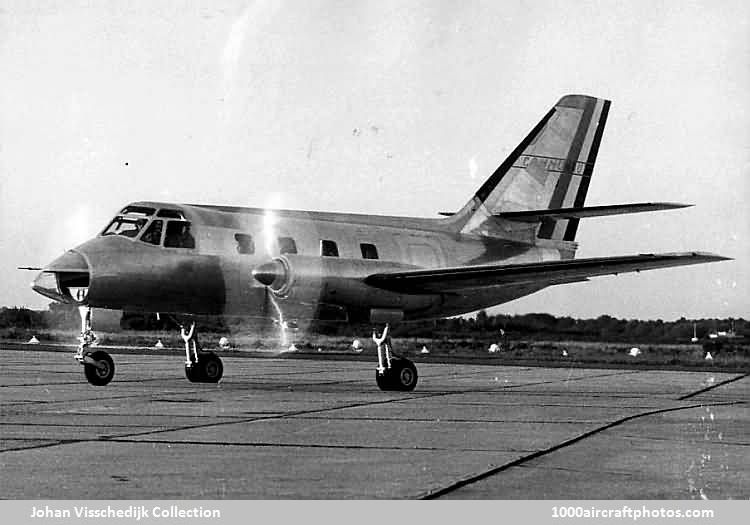The parallel developed M.D.410 Spirale was an operational version of the M.D.415 Communauté, intended for close support, reconnaissance, training and transport duties in the territories of the French Community. It had the same wing, tail unit, landing gear, Turboméca Bastan turboprop engines and many other components as the Communauté.
The M.D.410's main differences included a redesigned fuselage, transparent nose panels and armament. Fixed armament comprised two 1.18 in (30 mm) DEFA cannon or four 0.50 in (12.7 mm) machine guns. Under-wing attachments were provided for 2.68 in (68 mm) rockets, bombs or Nord SS.11 guided missiles.
The M.D.410 prototype flew for the first time on April 8, 1960, also registered F-WJDN. Shortly afterwards, both the M.D.415 and M.D.410 were abandoned, coinciding with an announcement from Sud-Aviation it would abandon its own twin-turboprop S.E.117 Voltigeur, built to the same formula.
Subsequently Dassault started working in collaboration with Sud-Aviation on a larger, high-wing development of the MD.415, known as the Spirale III, to meet a French Army requirement for a light military transport with short-field performance. However, this project was not materialized."
The following data relate to the M.D.415.
Type: Twin-engined light transport and training monoplane.
Wings: Low mid-wing cantilever monoplane. Wing section NACA 65,000 (modified). Aspect ratio 7.5. Chord 9 ft 10 in (3.0 m) at root, 3 ft 11 in (1.20 m) at tip. Dihedral 3° on center section, 4° 30' on outer wings. Sweepback 12° at 25% chord. All-metal structure with single main spar and front and rear auxiliary spars. All-metal ailerons and slotted flaps. Perforated spoilers forward of flaps in top surface on each side of engine nacelles. Trim-tab in each aileron. Goodrich de-icing rubber-boot on leading edges of outer wings.
Fuselage: All-metal semi-monocoque structure of circular section.
Tail unit: Cantilever monoplane type of all-metal construction, with tail plane mounted part-way up fin. 25° sweepback on tail plane at quarter-chord. 45° sweepback on fin at quarter-chord. Electrically-actuated variable incidence tail plane. Trim-tab in each elevator. De-icing boots on leading edges of tail plane and fin.
Landing gear: Retractable tricycle type. Hydraulic retraction. Twin wheels on each main unit and nose wheel identical, size 650 x 10, with tire pressure of 35.6-42.7 lb/sq.in (2.5-3.0 kg/sq.cm). Hydraulic single-disc brakes. Steerable nose wheel. Wheel track 16 ft 10.75 in (5.15 m). Wheel base 15 ft 1.1 in (4.60 m).
Power plant: Two Turboméca Bastan turboprop engines, each with take off rating of 1,000 shp plus 145 lb (66 kg) st and driving Ratier-Figeac three-blade variable pitch airscrews, diameter 9 ft (2.75 m). Fuel in six tanks in each wing, three inboard of nacelle and three outboard.
Accommodation: Crew of two. Air-conditioned and pressurized cabin. Normal accommodation for eight passengers in forward-facing individual seats, with baggage space and toilet at rear. Up to 14 passengers could be carried on folding troop-type seats facing inward along walls. Alternative arrangements provided for carrying freight, five cameras for reconnaissance or survey duties or four stretchers and a medical attendant. In training role, provision was made for three pupil pilots, a radio operator and instructor, or four pupil radar operators. Large upward-hinging freight door on the port side of the rear fuselage, measuring 3 ft 9 in wide and 3 ft 11 in high (1.15 m x 1.20 m). Passenger door contained within this; it measures 2 ft 2 in wide and 3 ft 6 in high (0.66 m x 1.06 m), and opened inward to permit the parachuting of men or supplies during flight.
